Effect of Thermal Fatigue on Microstructure and Mechanical Properties of H13 Tool Steel Processed by Selective Laser Surface Melting
Abstract
1. Introduction
2. Materials and Methods
3. Results and Discussion
3.1. Phase and Microstructure Analysis
3.2. Microhardness and Microstructural Evolution after Different Numbers of Thermal Fatigue Cycles
3.3. Tensile Properties at Room Temperature and Elevated Temperature after Different Numbers of Thermal Fatigue Cycles
3.4. Fracture Morphologies
4. Conclusions
Author Contributions
Funding
Conflicts of Interest
References
- Birol, Y. Response to thermal cycling of duplex-coated hot work tool steels at elevated temperatures. Mater. Sci. Eng. A 2011, 528, 8402–8409. [Google Scholar] [CrossRef]
- Duan, Z.X.; Pei, W.; Gong, X.B.; Chen, H. Superplasticity of Annealed H13 Steel. Materials 2017, 10, 870. [Google Scholar] [CrossRef] [PubMed]
- Salem, M.; Roux, S.L.; Dour, G.; Lamesle, P.; Choquet, K.; Rézaï-Aria, F. Effect of aluminizing and oxidation on the thermal fatigue damage of hot work tool steels for high pressure die casting applications. Int. J. Fatigue 2019, 119, 126–138. [Google Scholar] [CrossRef]
- Hao, G.C.; Liu, Z.Q.; Liang, X.L.; Zhao, J.F. Influences of TiAlN Coating on Cutting Temperature during Orthogonal Machining H13 Hardened Steel. Coatings 2019, 9, 355. [Google Scholar] [CrossRef]
- Sjöström, J.; Bergström, J. Thermal fatigue testing of chromium martensitic hot-work tool steel after different austenitizing treatments. J. Mater. Process. Technol. 2004, 153, 1089–1096. [Google Scholar] [CrossRef]
- Ning, A.; Mao, W.; Chen, X.; Guo, H.; Guo, J. Precipitation Behavior of Carbides in H13 Hot Work Die Steel and Its Strengthening during Tempering. Metals 2017, 7, 70. [Google Scholar] [CrossRef]
- Demir, H.; Gündüz, S.; Erden, M.A. Influence of the heat treatment on the microstructure and machinability of AISI H13 hot work tool steel. Int. J Adv. Manuf. Tech. 2018, 95, 2951–2958. [Google Scholar] [CrossRef]
- Zhang, Y.; Li, J.; Shi, C.B.; Qi, Y.F.; Zhu, Q.T. Effect of Heat Treatment on the Microstructure and Mechanical Properties of Nitrogen-Alloyed High-Mn Austenitic Hot Work Die Steel. Metals 2017, 7, 94. [Google Scholar] [CrossRef]
- Junker, D.; Hentschel, O.; Schmidt, M.; Merklein, M. Investigation of Heat Treatment Strategies for Additively-Manufactured Tools of X37CrMoV5-1. Metals 2018, 8, 854. [Google Scholar] [CrossRef]
- Çiçek, A.; Kara, F.; Kıvak, T.; Ekici, E.; Uygur, İ. Effects of Deep Cryogenic Treatment on the Wear Resistance and Mechanical Properties of AISI H13 Hot-Work Tool Steel. J. Mater. Eng. Perform. 2015, 24, 4431–4439. [Google Scholar] [CrossRef]
- Jiang, Q.C.; Zhao, X.M.; Qiu, F.; Ma, T.N.; Zhao, Q.L. The Relationship Between Oxidation and Thermal Fatigue of Martensitic Hot-Work Die Steels. Acta. Metall. Sin Engl. 2018, 31, 692–698. [Google Scholar] [CrossRef]
- Kheirandish, S.; Noorian, A. Effect of Niobium on Microstructure of Cast AISI H13 Hot Work Tool Steel. J. Iron Steel Res. Int. 2008, 15, 61–66. [Google Scholar] [CrossRef]
- Zhou, J.; Ma, D.S.; Chi, H.X.; Chen, Z.Z.; Li, X.Y. Microstructure and Properties of Hot Working Die Steel H13MOD. J. Iron Steel Res. Int. 2013, 20, 117–125. [Google Scholar] [CrossRef]
- Birol, Y.; Isler, D. Abrasive wear performance of AlCrN-coated hot work tool steel at elevated temperatures under three-body regime. Wear 2011, 270, 281–286. [Google Scholar] [CrossRef]
- Norhafzan, B.; Aqida, S.N.; Chikarakara, E.; Brabazon, D. Surface modification of AISI H13 tool steel by laser cladding with NiTi powder. Appl. Phys. A 2016, 122, 384–390. [Google Scholar] [CrossRef]
- Aqida, S.N.; Calosso, F.; Brabazon, D.; Naher, S.; Rosso, M. Thermal fatigue properties of laser treated steels. Int. J. Mater. Form. 2010, 3, 797–800. [Google Scholar] [CrossRef]
- Fauzun, F.; Aqida, S.N.; Naher, S.; Brabazon, D.; Calosso, F.; Rosso, M. Effects of Thermal Fatigue on Laser Modified H13 Die Steel. J. Mech. Sci. Technol. 2014, 6, 975–980. [Google Scholar] [CrossRef]
- Ley, N.; Joshi, S.S.; Zhang, B.Z.; Ho, Y.H.; Dahotre, N.B.; Young, M.L. Laser coating of a CrMoTaWZr complex concentrated alloy onto a H13 tool steel die head. Surf. Coat. Technol. 2018, 384, 150–158. [Google Scholar] [CrossRef]
- Orečný, M.; Buršák, M.; Šebek, M.; Falat, L. Influence of Hardness, Matrix and Carbides in Combination with Nitridation on Abrasive Wear Resistance of X210Cr12 Tool Steel. Metals 2016, 6, 236. [Google Scholar] [CrossRef]
- Jose, M.P.; German, F.R.; Edinei, L.J.; Pietro, S.; Yassmin, S.A.; Marcelo, M.M.; Carlos, B.; Stephen, V. Tribological and Wear Performance of Nanocomposite PVD Hard Coatings Deposited on Aluminum Die Casting Tool. Materials 2018, 11, 358. [Google Scholar] [CrossRef]
- Wang, G.Y.; Zhang, J.Z.; Shu, R.Y.; Yang, S. High temperature wear resistance and thermal fatigue behavior of Stellite-6/WC coatings produced by laser cladding with Co-coated WC powder. Int. J. Refract. Met. 2019, 81, 63–70. [Google Scholar] [CrossRef]
- Kamat, S.; Su, X.; Ballarini, R.; Henuer, A.H. Structural basis for the fracture toughness of the shell of the conth Strombus gigas. Nature 2000, 405, 1036–1040. [Google Scholar] [CrossRef] [PubMed]
- Tu, J.; Zhou, K.F.; Zhou, Z.M.; Huang, C.; Tang, H.L. Microstructural characteristics of cobalt treated by high-speed laser surface melting under high power. Mater. Charact. 2017, 128, 63–67. [Google Scholar] [CrossRef]
- Park, J.; Han, H.S.; Park, J.; Seo, H.; Edwards, J.; Kim, Y.C.; Ok, M.R.; Seok, H.K.; Jeon, H. Corrosion behavior of biodegradable Mg-based alloys via femtosecond laser surface melting. Appl. Surf. Sci. 2018, 448, 424–434. [Google Scholar] [CrossRef]
- Zhou, H.; Cao, Y.; Zhang, Z.H.; Ren, L.Q.; Li, X.Z. Thermal fatigue behavior of 3Cr2W8V die steel with biomimetic non-smooth surface. Mater. Sci. Eng. A 2006, 433, 144–148. [Google Scholar] [CrossRef]
- Zhou, H.; Zhang, Z.H.; Ren, L.Q.; Song, Q.F.; Chen, L. Thermal fatigue behavior of medium carbon steel with striated non-smooth surface. Surf. Coat. Technol. 2006, 200, 6758–6764. [Google Scholar] [CrossRef]
- Zhang, Z.H.; Zhou, H.; Ren, L.Q.; Tong, X.; Shan, H.Y.; Liu, L. Effect of units in different sizes on thermal fatigue behavior of 3Cr2W8V die steel with biomimetic non-smooth surface. Int. J. Fatigue 2009, 31, 468–475. [Google Scholar] [CrossRef]
- Cong, D.L.; Zhou, H.; Ren, Z.A.; Zhang, Z.H.; Zhang, H.F.; Meng, C.; Wang, C.W. The thermal fatigue resistance of H13 steel repaired by a biomimetic laser remelting process. Mater. Design 2014, 55, 597–604. [Google Scholar] [CrossRef]
- Cong, D.L.; Zhou, H.; Ren, Z.A.; Zhang, Z.H.; Zhang, H.F.; Ren, L.Q.; Meng, C.; Wang, C.W. Thermal fatigue resistance of hot work die steel repaired by partial laser surface remelting and alloying process. Opt. Laser. Eng. 2014, 54, 55–61. [Google Scholar] [CrossRef]
- Cong, D.L.; Li, Z.S.; He, Q.B.; Chen, D.J.; Chen, H.B.; Yang, J.Z.; Zhang, P.; Zhou, H. Effect of unit size on thermal fatigue behavior of hot work steel repaired by a biomimetic laser remelting process. Opt. Laser Technol. 2018, 98, 205–213. [Google Scholar] [CrossRef]
- Jia, Z.X.; Li, J.Q.; Liu, L.J.; Liu, Y.W.; Wang, Y.Q.; Li, H.L. Influence and application of laser parameters on unit of H13 steel by laser remelting process. Int. J. Adv. Manuf. Technol. 2015, 79, 551–568. [Google Scholar] [CrossRef]
- Chen, L.Q.; Liu, L.J.; Jia, Z.X.; Li, J.Q.; Wang, Y.Q.; Hu, N.B. Method for improvement of die-casting die: Combination use of CAE and biomimetic laser process. Int. J. Adv. Manuf. Technol. 2013, 68, 2841–2848. [Google Scholar] [CrossRef]
- Gu, S.T.; Chai, G.Z.; Wu, H.P.; Bao, Y.M. Characterization of local mechanical properties of laser-cladding H13-TiC composite coatings using nanoindentation and finite element analysis. Mater. Design 2012, 39, 72–80. [Google Scholar] [CrossRef]
- Aqida, S.N.; Brabazon, D.; Naher, S. An investigation of phase transformation and crystallinity in laser surface modified H13 steel. Appl. Phys. A 2013, 110, 673–678. [Google Scholar] [CrossRef]
- Kwok, C.T. Laser Surface Modification of Alloys for Corrosion and Erosion Resistance, 1st ed.; Woodhead Publishing Limited: Oxford, UK, 2017; p. 53. [Google Scholar]
- Wang, M.; Li, W.; Wu, Y.; Li, S.; Cai, C.; Wen, S.F.; Wei, Q.S.; Shi, Y.S.; Ye, F.Y.; Chen, Z.P. High-Temperature Properties and Microstructural Stability of the AISI H13 Hot-Work Tool Steel Processed by Selective Laser Melting. Metall. Mater. Trans. B 2019, 50, 531–542. [Google Scholar] [CrossRef]
- Chen, H.Y.; Gu, D.D.; Dai, D.H.; Xia, M.J.; Ma, C.L. A novel approach to direct preparation of complete lath martensite microstructure in tool steel by selective laser melting. Mater. Lett. 2018, 227, 128–131. [Google Scholar] [CrossRef]
- Wang, Q.; Zhang, S.; Zhang, G.H.; Wang, J.Q.; Babar Shahzad, M.; Chen, H.T.; Chen, J. A high strength low alloy steel fabricated by direct laser deposition. Vacuum 2019, 161, 225–231. [Google Scholar] [CrossRef]
- Cong, D.L.; Zhou, H.; Ren, Z.A.; Ren, L.Q.; Kiu, G.Y.; Lu, B.S.; Meng, C.; Wang, C.W. Thermal fatigue resistance of H13 die steel repaired by partial laser surface remelting process. Mater. Sci. Technol. 2014, 30, 355–362. [Google Scholar] [CrossRef]
- Hu, X.B.; Li, L.; Wu, X.C.; Zhang, M. Coarsening behavior of M23C6 carbides after ageing or thermal fatigue in AISI H13 steel with niobium. Int. J. Fatigue 2006, 28, 175–182. [Google Scholar] [CrossRef]
- Meng, C.; Chen, Z.K.; Li, G.; Dong, P. Effect of laser surface melting on high temperature tensile properties of AZ91D magnesium alloy. J. Alloy. Compd. 2017, 711, 258–266. [Google Scholar] [CrossRef]
- Wang, C.W.; Zhou, H.; Zhang, Z.Z.; Jing, Z.J.; Cong, D.L.; Meng, C.; Ren, L.Q. Tensile property of low carbon steel with gridding units. Appl. Surf. Sci. 2013, 27, 128–134. [Google Scholar] [CrossRef]
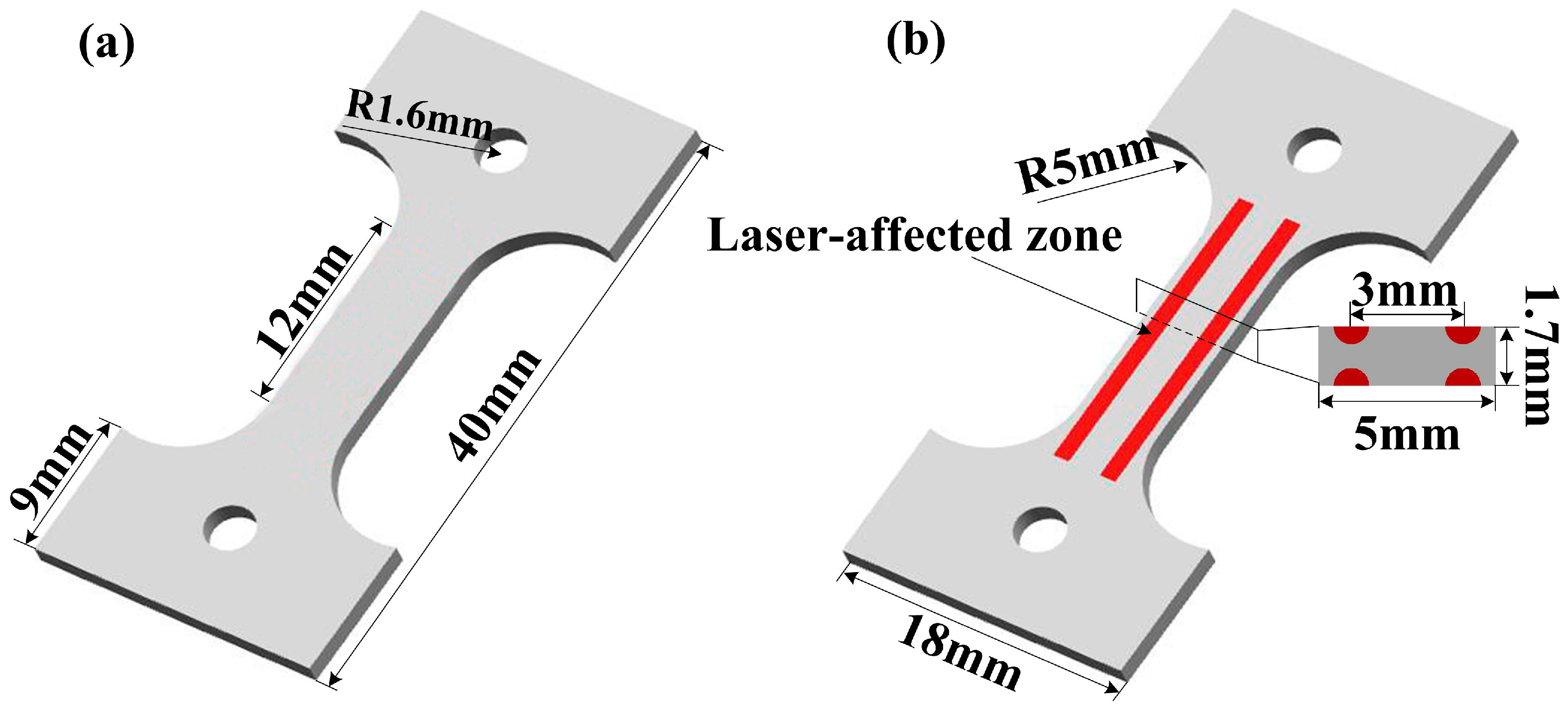



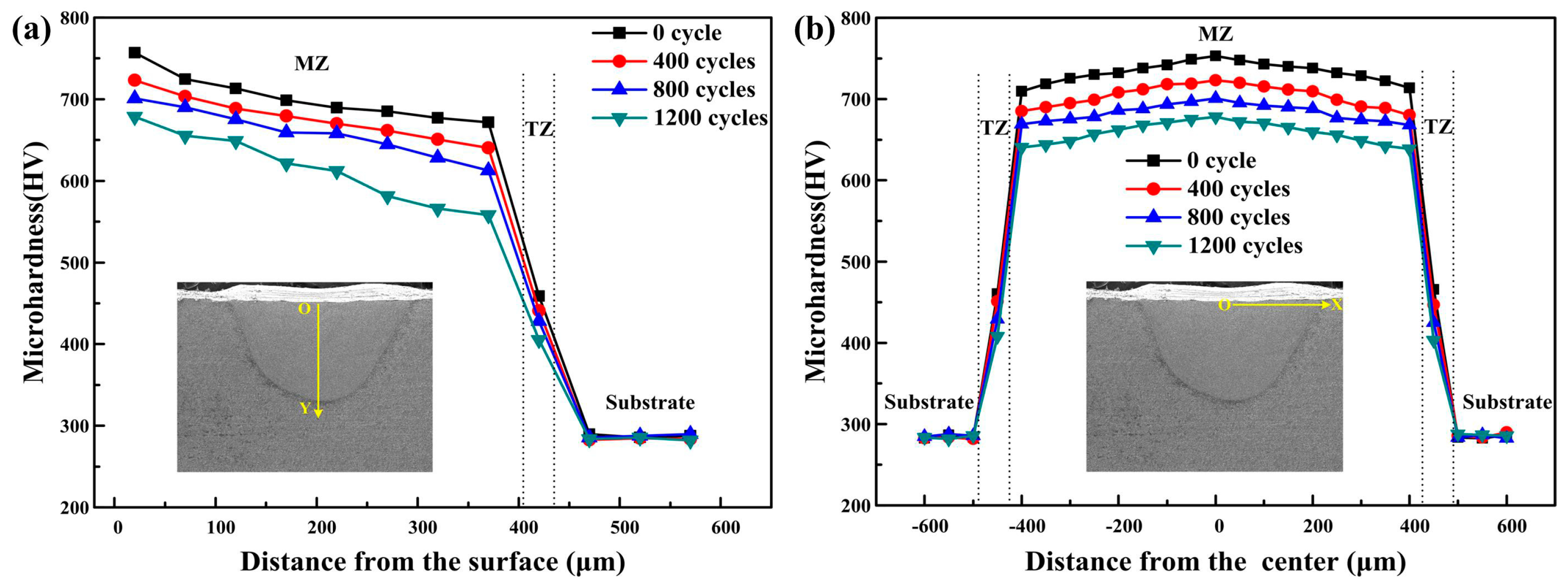

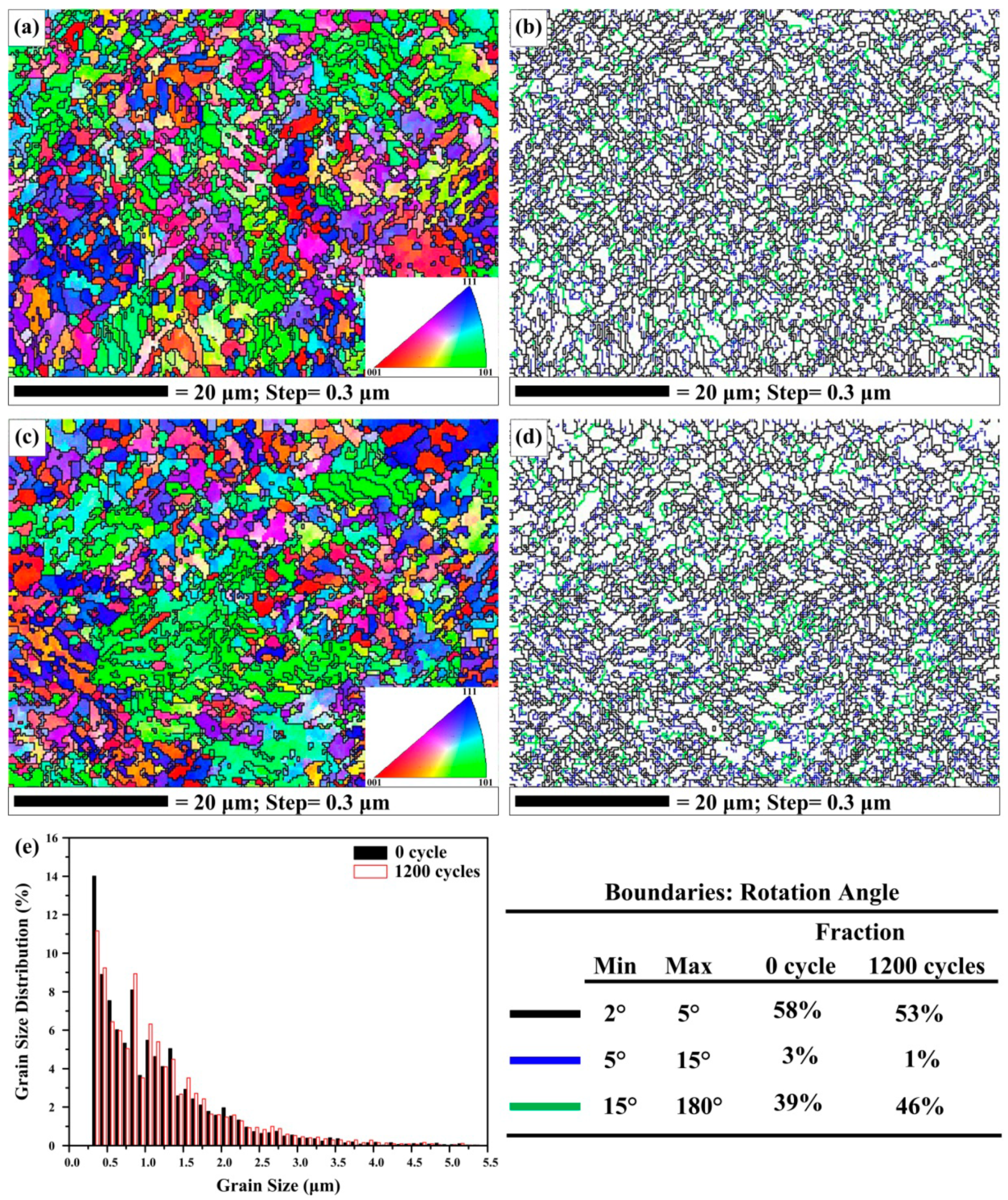
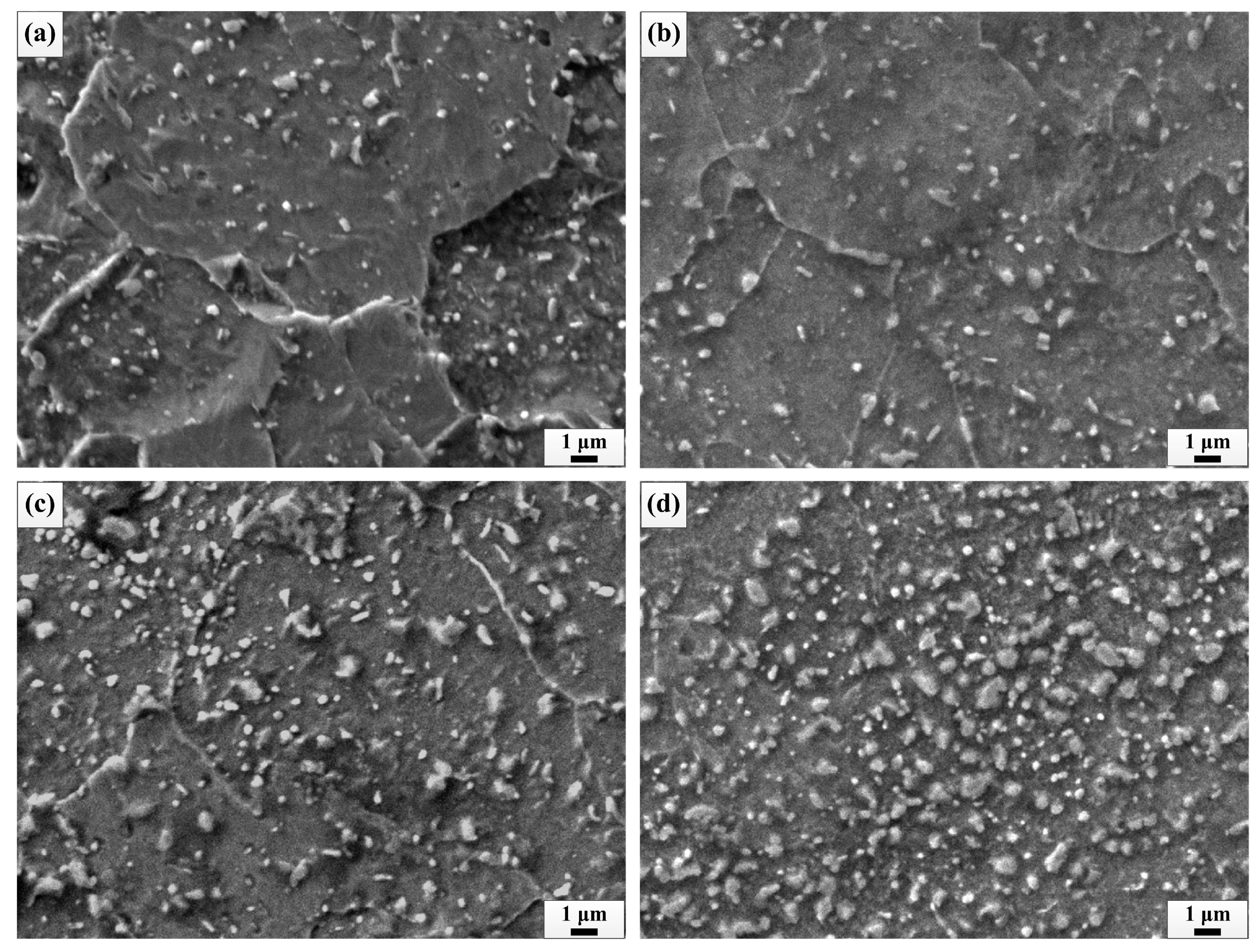
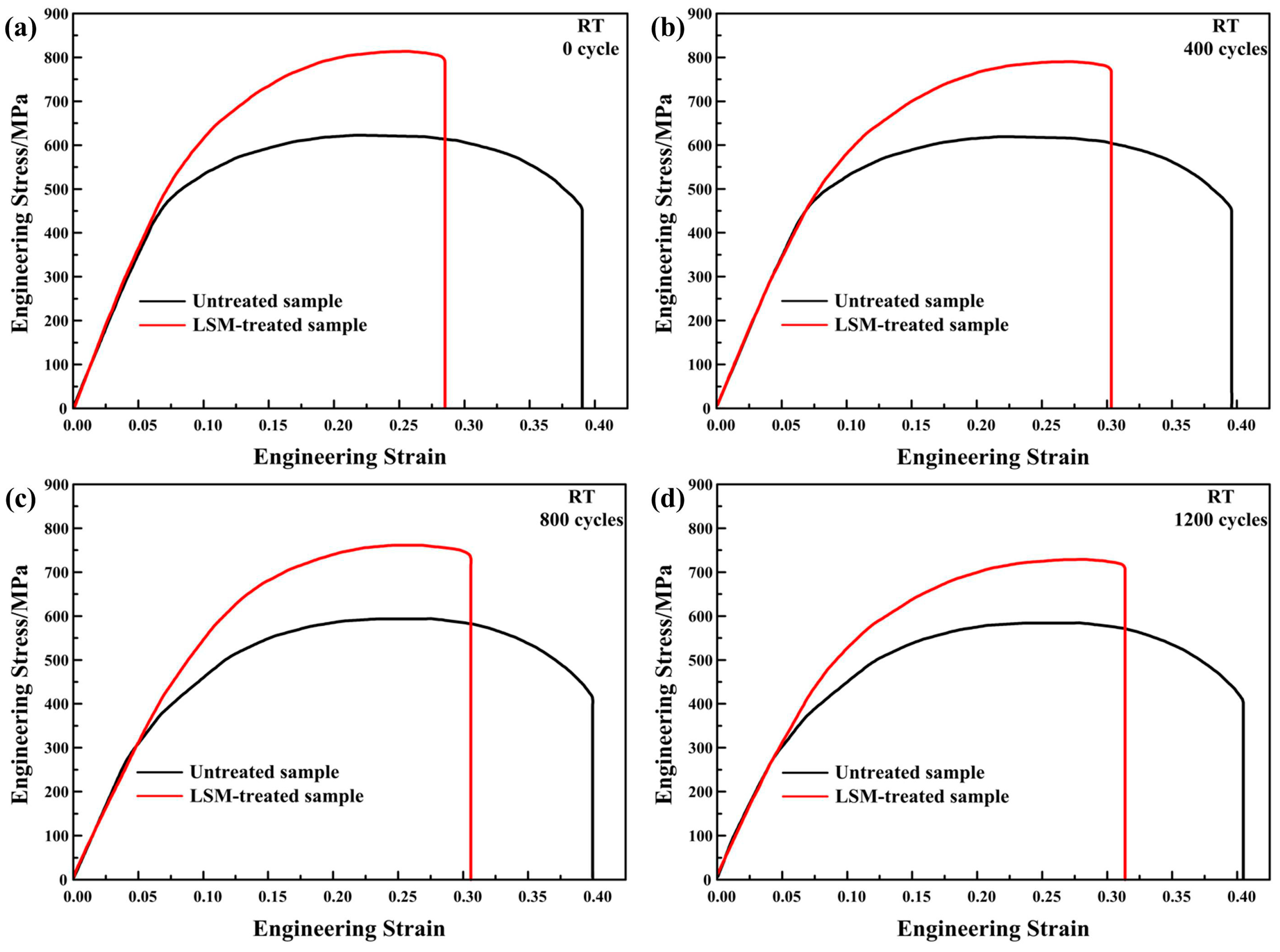
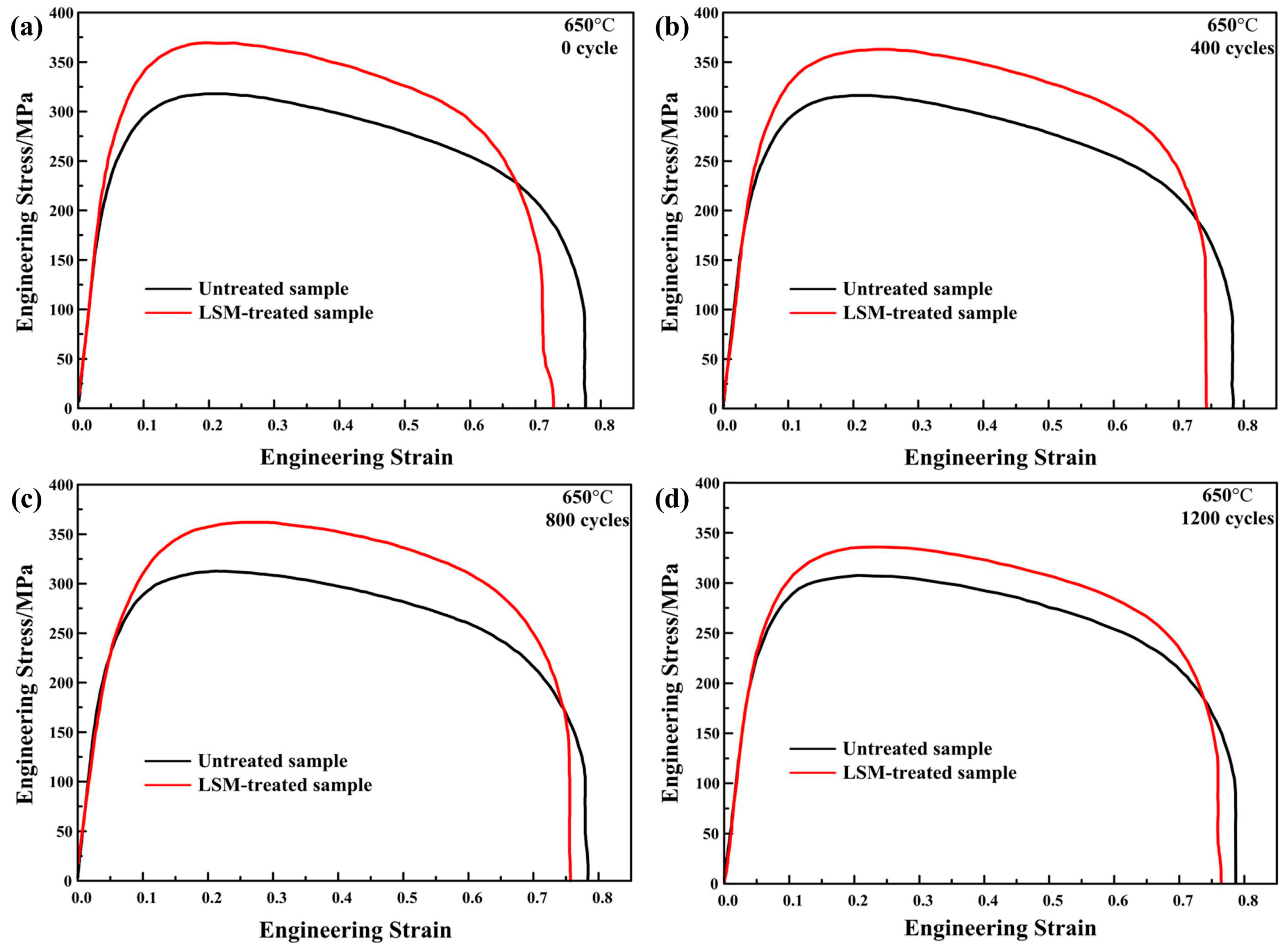
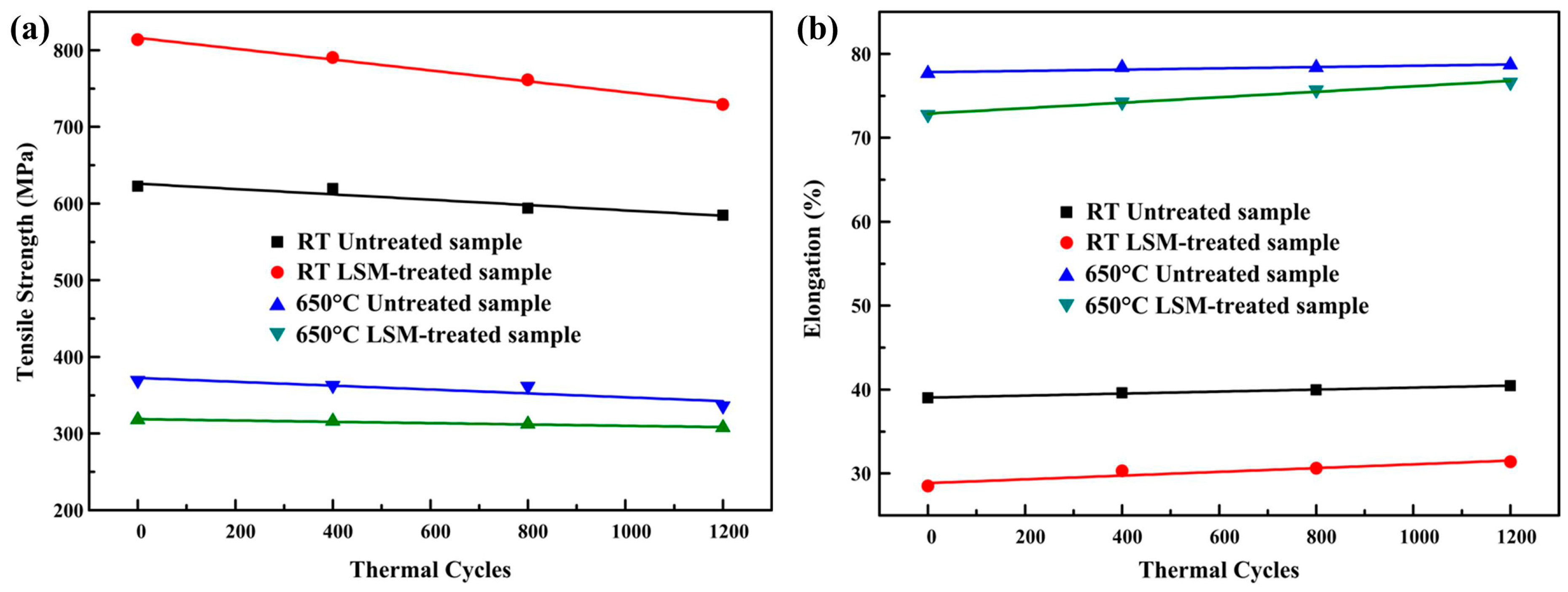
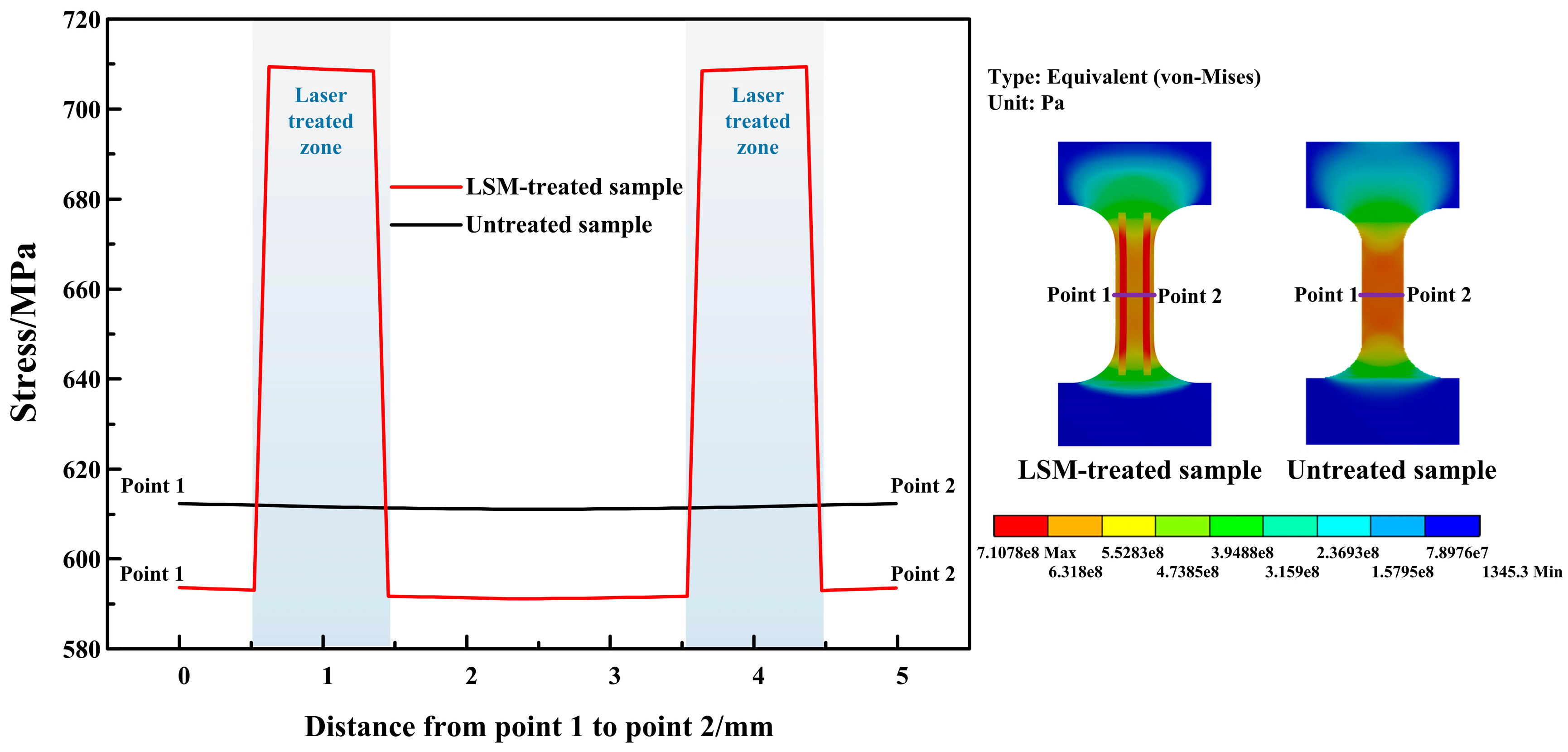
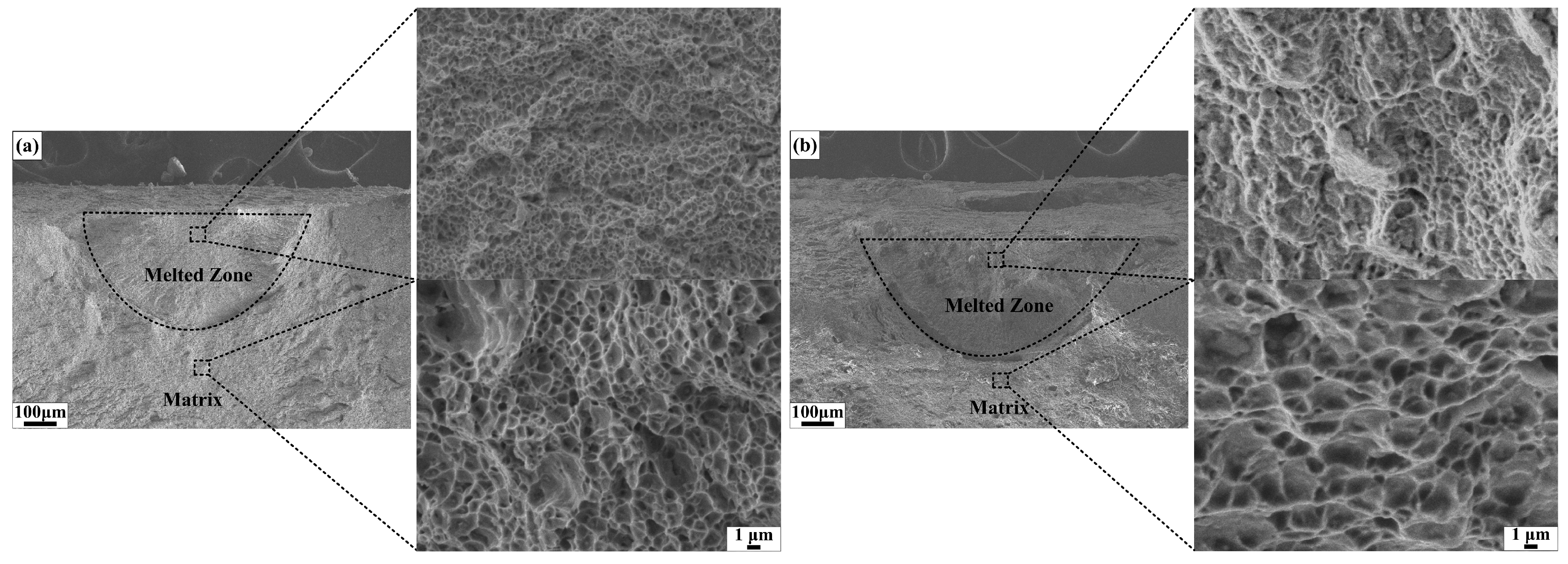

| Composition | C | Si | Mn | Cr | V | Mo | Ni | P | S | Fe |
|---|---|---|---|---|---|---|---|---|---|---|
| Content | 0.42 | 0.78 | 0.25 | 4.82 | 0.83 | 1.38 | 0.10 | 0.007 | 0.001 | Bal. |
| Pulse Energy (J) | Pulse Duration(ms) | Frequency (Hz) | Scanning Speed (mm/s) | Defocusing (mm) |
|---|---|---|---|---|
| 12.5 | 5 | 5 | 1 | 8 |
| Head | Elasticity Modulus (GPa) | Destiny (g/cm3) | Possion Ratio |
|---|---|---|---|
| Substrate | 210 GPa | 7.85 | 0.3 |
| Laser-affected zone | 255 GPa [33] | 7.85 | 0.3 |
© 2019 by the authors. Licensee MDPI, Basel, Switzerland. This article is an open access article distributed under the terms and conditions of the Creative Commons Attribution (CC BY) license (http://creativecommons.org/licenses/by/4.0/).
Share and Cite
Meng, C.; Wu, C.; Wang, X.; Li, J.; Cao, R. Effect of Thermal Fatigue on Microstructure and Mechanical Properties of H13 Tool Steel Processed by Selective Laser Surface Melting. Metals 2019, 9, 773. https://doi.org/10.3390/met9070773
Meng C, Wu C, Wang X, Li J, Cao R. Effect of Thermal Fatigue on Microstructure and Mechanical Properties of H13 Tool Steel Processed by Selective Laser Surface Melting. Metals. 2019; 9(7):773. https://doi.org/10.3390/met9070773
Chicago/Turabian StyleMeng, Chao, Chun Wu, Xuelei Wang, Jingyue Li, and Rui Cao. 2019. "Effect of Thermal Fatigue on Microstructure and Mechanical Properties of H13 Tool Steel Processed by Selective Laser Surface Melting" Metals 9, no. 7: 773. https://doi.org/10.3390/met9070773
APA StyleMeng, C., Wu, C., Wang, X., Li, J., & Cao, R. (2019). Effect of Thermal Fatigue on Microstructure and Mechanical Properties of H13 Tool Steel Processed by Selective Laser Surface Melting. Metals, 9(7), 773. https://doi.org/10.3390/met9070773





